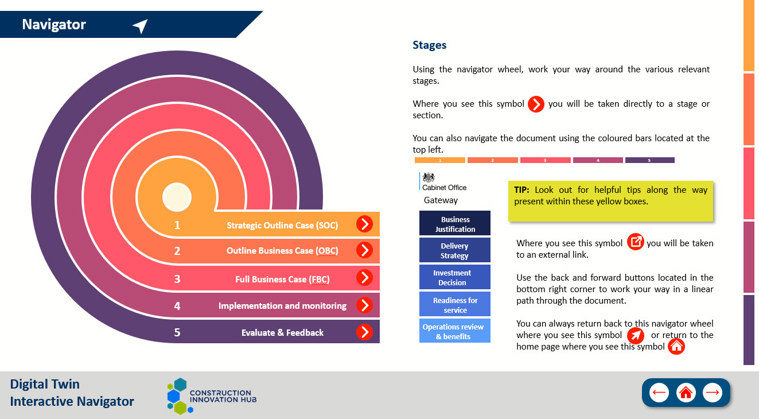Bridge Programme
Platform ProgrammeThe Construction Playbook (2020) highlights the need for appointing parties, such as asset owner clients, to further embed digital technologies and processes, especially the UK BIM Framework and digital twins, as a vehicle to improve the performance, sustainability and value for money of projects and programmes allowing for the effective retention and management of the ‘golden thread’ of information.
The concept of digital twinning is not new and it is an increasingly commonly used term in our ever complex built environment. It is already mature in adjacent sectors, especially those undertaking advanced manufacture workflows where machine-to-machine communication and machine-learning technology is used to optimise productivity and enhance levels of automation. In these environments, data from sensing devices in the physical asset is pervasively analysed to monitor condition and optimise efficiency, mostly in a real-time status.
For some, digital twinning is about understanding how the power of data can help to unlock value. For others, digital twins are the next step on their journey to digital maturity that can help them to achieve their organisational objectives and wider societal benefits.
The concept was highlighted in the National Infrastructure Commission (NIC) Data for the public good (2018) report, which reinforced that data is infrastructure and creates value. The report imagined the value of data in the context of digital twinning as a means of monitoring our built infrastructure in real-time and simulating the impact of potential future scenarios. The digital twin (DT), especially at a wide spatial scale, could optimise networks, prevent asset failure and better target maintenance interventions.
The opportunity of the digital twin and harnessing the value of data in the built environment was further envisioned in the Gemini Principles (2018) where it can help assets perform better over their lifetime and use less energy. Importantly the Gemini Principles established a proposed definition of a digital twin in the context of the built environment:
“a realistic digital representation of assets, processes or systems in the built or natural environment.”
Crucially it further noted that what distinguishes a digital twin from any other digital model is its connection to the physical twin based on data from the physical asset or system. It also noted potential variety or sophistication levels within a digital twin or digital twin ecosystem from purpose, spatial scales, temporal scales to a variety of approaches to modelling.
More importantly, however, it enshrined consensus values with the notion that all digital twins must have clear purpose, must be trustworthy and must function effectively. These are the principles that this guidance is founded upon.
These reports have highlighted the value proposition of digital twinning at a headline level; however, as early adopter organisations now begin to meaningful consider applying a digital twin approach to their projects, it is important to provide guidance to help ensure that a DT approach is properly considered from the earliest stages of the project lifecycle to ensure it is appropriate, proportionate and included in the business case(s), brief and subsequent procurement process.
To help with this the Construction Innovation Hub (Hub) has produced guidance that provides a framework for client organisations to consider embedding digital twinning into an individual project.
The guide will help inform a clear DT strategy during the initial stages of a project and influence the brief and subsequently the design and delivery teams during the early engagement stages in design and selection, specification of data acquisition systems, services, and control systems. The DT strategy will also influence any modelling (such as BIM) and IT network architecture that should be aligned with this plan.
The guide uses an intuitive navigation wheel, divided into five stages, to guide your way around the document. This allows it to be read in a linear fashion, or you can go straight to the relevant section, where each stage clearly sets out the associated tasks and actions you may need to consider for a DT. Early stages are aligned to HM Treasury Guide to developing Project Business Cases. Beyond investment decisions, Gateways 4 and 5 are aligned with the Cabinet Office Gateway review process. The principles of the guide can, however, be used to suit wider procurement routes.

In summary, the UK is well placed to harness the opportunities of digital twinning, new data capture and processing technologies. However, it must be founded on good values (Gemini principles) and information models that are secure and of quality data to connect with (UK BIM Framework).
As our built environment responds to ever-increasing challenges, especially around resilience and low carbon, the shift to practical cyber-physical approaches is becoming ever more important not just for our individual project but our global society.
Blog post written by David Philp, Impact Director for the Construction Innovation Hub.